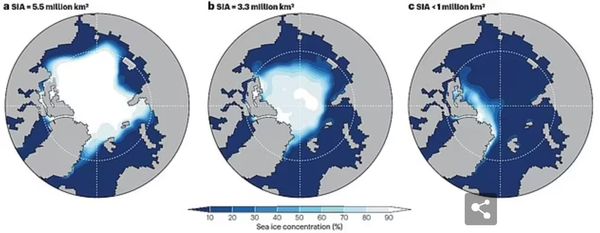
Researchers are sounding the alarm as the Arctic experiences its sixth-lowest minimum ice extent since satellite tracking began. This worrying trend is not new, but it is getting worse. The Arctic sea ice has been steadily decreasing since NASA started observing it in 1978. According to recent analysis, there is a looming possibility that the Arctic could experience ice-free conditions in September by the 2020s or 2030s. However, “ice-free” does not mean a complete absence of ice. It signifies less than a million square kilometers of ice coverage.
Even during the 2023 minimum, Arctic sea ice covered 1.63 million square miles or 4.23 million square kilometers. Predictions suggest that by the 2030s, summer ice in the Arctic could shrink to approximately 24 percent of its 2023 size, regardless of emission scenarios. Scientists anticipate that this reduction will continue, projecting more frequent ice-free conditions in the Arctic by 2067, extending beyond just September to include August and October.
However, there is hope. Mitigating greenhouse gas emissions could delay this milestone. Arctic ice melting is highly sensitive to carbon emission fluctuations, meaning that reducing emissions could prevent prolonged ice-free periods. Alexandra Jahn, the lead author of the study, emphasizes the urgent need for emission reduction efforts. Even if ice-free conditions are inevitable, minimizing emissions is crucial to prevent prolonged ice-free periods.
These projections are not based on a single data source but on comprehensive analyses integrating various research findings. They carry significant consequences, especially for wildlife that depends on sea ice. Polar bears, for example, rely on sea ice for hunting and are facing escalating challenges as their habitat diminishes.
The melting Arctic ice also has implications for shipping and commercial interests in the region. As Arctic ice decreases, navigation becomes easier for shipping, which could benefit commercial activities. Many companies, particularly from China, are already operating in Russian-controlled Arctic territories, but this surge in maritime activity poses new challenges for wildlife, especially marine mammals like blue whales. The noise from ship engines can interfere with whale communication, further threatening their survival.
Moreover, the melting Arctic ice contributes to global warming by reducing the Earth’s albedo effect. Declining ice cover diminishes the reflective surface that bounces sunlight back into space, which in turn accelerates the rate of melting and increases oceanic heat absorption. This feedback loop intensifies the frequency and severity of heatwaves, perpetuating a vicious cycle of warming and melting.
While the projections are concerning, the Arctic has shown its ability to respond to climate change. Unlike long-term geological processes, Arctic sea ice can regenerate relatively quickly if emissions are reduced. This highlights the importance of taking swift and decisive action to mitigate climate change and preserve the ecological integrity of the Arctic.





